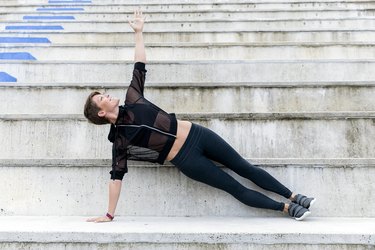
The muscles of your lower back and waist are pretty important. They connect your upper and lower body, helping them work together for easy movement in your daily activities and athletic endeavors.
Your core muscles also help keep you erect and support your spine for good posture, which enables you to move better and can help prevent back pain. And, of course, a toned midsection makes you look and feel great.
Video of the Day
To get all these benefits, try the below workout or add a few specific lower back and waist exercises to your current routine.
Do: all of the exercises below, resting as needed. Then repeat the circuit two more times (three rounds total).
Move 1: Bicycle Crunch
- Lie on your back on an exercise mat with your legs extended and your fingers gently supporting your head just behind your ears.
- Raise your legs and bend your knees to a 90-degree angle so your calves are parallel with the mat.
- Lift your shoulder blades off the mat, press your lower back into the floor and contract your abs by pulling your belly button in toward your spine.
- Exhale as you bring your right knee to your left elbow, extending your left leg and rotating your torso to the left.
- Gently tap knee to elbow, then inhale as you release to center.
- Switch sides.
Tip
Bicycle crunches are one of the most effective exercises for working your obliques, the muscles that run along the sides of your torso.
Make sure to get a full range of motion and focus on keeping your core muscles — abs, obliques and lower back — contracted throughout the movement.
Move 2: Bird Dog
- Start on all fours, palms directly under your shoulders and knees directly under your hips.
- Keeping your hips steady and neck long, reach your right arm out parallel to the ground.
- Simultaneously raise and extend your left leg straight behind you.
- Pause here for a moment, then return to the starting position.
- Repeat on the opposite side, simultaneously extending your left arm and right leg.
Move 3: Forearm Plank
- Lie face down on the floor, with your forearms on the ground, elbows directly beneath your shoulders.
- Extend your legs straight behind you, toes tucked.
- With your core braced, press into your toes and forearms and raise your body up off the ground.
- Keep your back flat and your body in a straight line from head to hips to heels.
Tip
The traditional plank exercise is an isometric exercise that works your superficial and deep abdominal muscles, your lower back and your obliques. It's held for a period of time -- 30 seconds to 3 minutes, or more, depending on your core strength. Keep challenging your muscles by doing different variations of the exercise.
Move 4: Side Plank
- Lie on your side with your upper body supported by your bottom arm. Stack your feet on top of each other.
- Press into your bottom foot and hand and lift up into a side plank. Your body should be in a straight line from head to hips to heels.
Move 5: Side Plank With Knee Tuck
- Start in a side plank balancing either on your hand or your forearm. Your elbow should be stacked directly under your shoulder. Keep your body in one straight line from your feet to your shoulders as you raise your top arm up toward the ceiling.
- Use your abdominal muscles to bend your top knee and top arm until your knee meets your elbow.
- Lower your leg down and straighten your arm high.
- Complete all your reps on one side before switching to the other.
Move 6: Russian Twist
- Begin seated and lean back slightly. If your abs are strong enough, lift your feet a few inches off the floor. Either hold your hands in a fist at the center of your chest or extend your arms out in front of you.
- Keeping your core engaged, twist your upper body to the right without lowering your feet or arching your back.
- Hold for a second before twisting back the other way.
- Continue alternating sides without compromising your form.
Move 7: Back Extension
- Face a stability ball, plant your feet on the floor and rest your hips and stomach on the ball.
- Bring your hands behind your head and engage the muscles up and down your back to raise your upper body off the ball.
- Slowly lower back down to the start. Be careful not to strain your neck or lower back as you do this exercise.
Tip
Don't have a stability ball? Do this move while lying on the floor or bracing yourself on the edge of a couch.